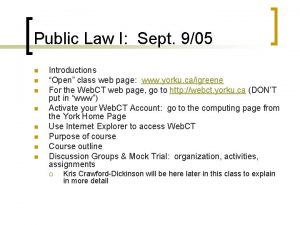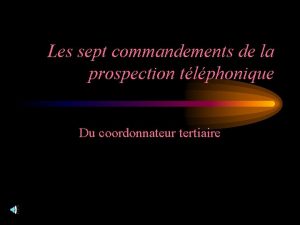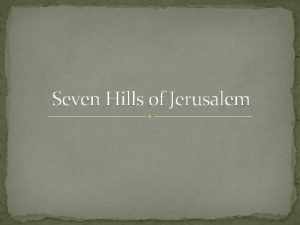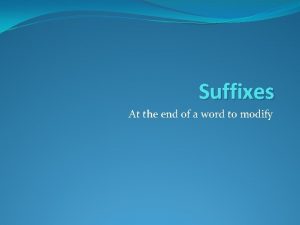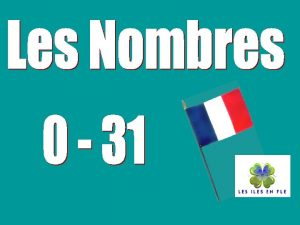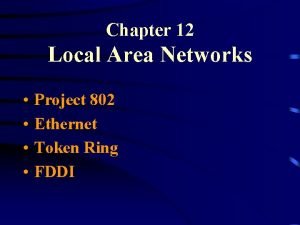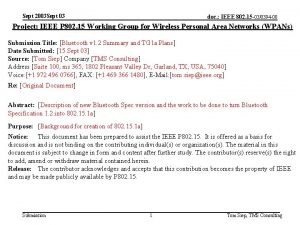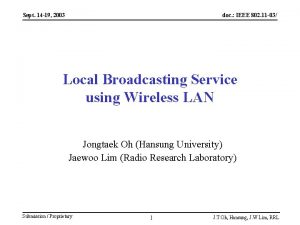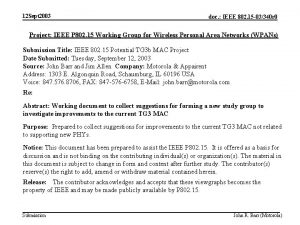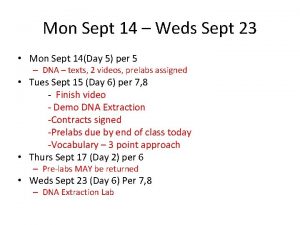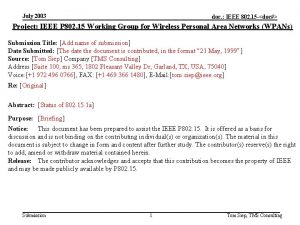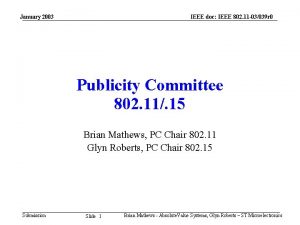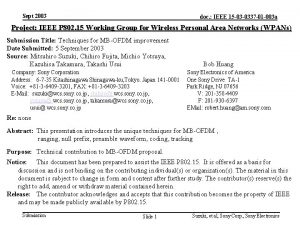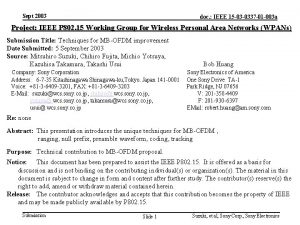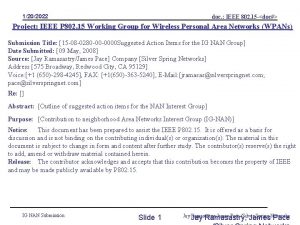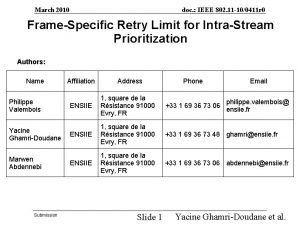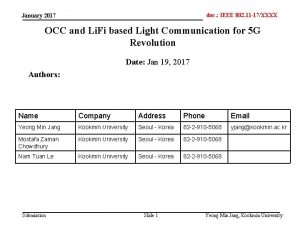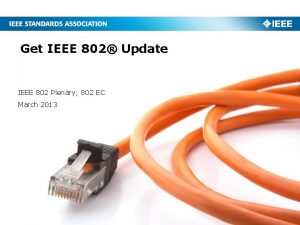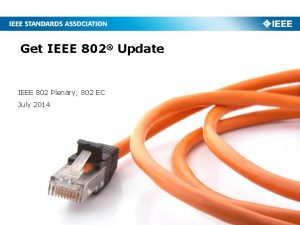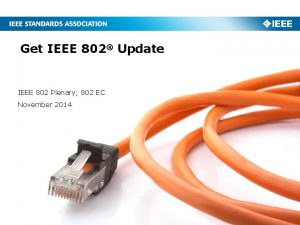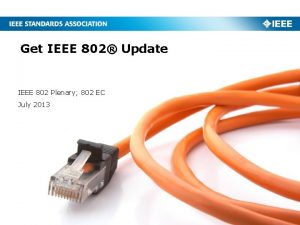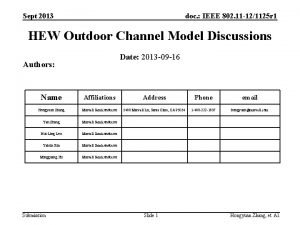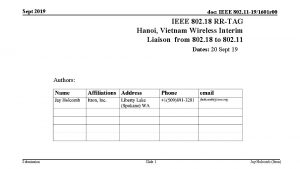Sept 2003 doc IEEE 802 11 03714 r


























- Slides: 26

Sept 2003 doc. : IEEE 802. 11 -03/714 r 0 Backwards compatibility How to make a MIMO-OFDM system backwards compatible and coexistence with 11 a/g at the link level. Jan Boer, Bas Driesen and Pieter-Paul Giesberts, Agere Systems Submission 1 Jan Boer, Agere Systems

Sept 2003 doc. : IEEE 802. 11 -03/714 r 0 The PAR • Some of the modes of operation defined in the HT amendment shall be backwards compatible and interoperable with 802. 11 a and/or 802. 11 g. Submission 2 Jan Boer, Agere Systems

Sept 2003 doc. : IEEE 802. 11 -03/714 r 0 Meaning for MIMO-OFDM – Any higher order MIMO-OFDM system (with n Rx antennas) can receive a signal from a lower order MIMO/SISO transmitter (< n Tx antennas, SISO = 11 a or 11 g) – Detection of preamble, interpretation of the header: • Determining the number of transmit antennas (number of data streams) and switch Rx accordingly – Any higher order MIMO-OFDM transmitter (n Tx antennas) can transmit a signal that a lower order MIMO/SISO receiver can receive – Switch back to (ultimately) 11 a or 11 g * order of MIMO system is dependent on # Tx antennas Submission 3 Jan Boer, Agere Systems

Sept 2003 doc. : IEEE 802. 11 -03/714 r 0 Coexistence requirement • Any lower order system (with n Rx antennas) that cannot receive data of a transmitter (with more than n antennas) defers while this transmitter is sending, because it is capable to detect the start of this transmission and retrieve the length (duration) of this transmission. – Defer not on power only – Detection of the preamble and interpretation of the length field, – Using existing multirate capabilities of the current standard(s) Submission 4 Jan Boer, Agere Systems

Sept 2003 doc. : IEEE 802. 11 -03/714 r 0 Backward Compatible Preambles • 11 a/g preamble structure must be maintained • Two examples are given of preamble structures that can be made backward compatible and coexistent: – Repetition preamble – Diagonally loaded preamble • 3 rd way: use protection mechanisms as defined in 11 g Submission 5 Jan Boer, Agere Systems

Sept 2003 doc. : IEEE 802. 11 -03/714 r 0 1. Repeating preamble TX 1 ST GI LT 1 LT 2 Signal Sign 2 TX 2 GI LT 1 LT 2 TX 3 GI LT 1 LT 2 • 802. 11 a Long Training Symbols (including Guard Interval) repeated on every transmit antenna, separated in time • Channel training length equal to n times length 802. 11 a training • Following is an example for 3 antenna MIMO Tx: Submission 6 Jan Boer, Agere Systems

Sept 2003 doc. : IEEE 802. 11 -03/714 r 0 3 x 3 Mimo Rx vs 11 a Rx training ST TX 1 GI LT 1 LT 2 • 3 x 3 Mimo • 11 a – Detects short training symbols – Channel estimation (3 paths), etc Submission – Detects short training symbols – Channel estimation 7 Jan Boer, Agere Systems

Sept 2003 doc. : IEEE 802. 11 -03/714 r 0 MIMO notification TX 1 ST GI LT 1 LT 2 Signal • The Reserved bit 4 in the signal field is used to signal a MIMO transmission (R=1? ) • 11 a-1999 standard says: Bit 4 shall be reserved for future use • The 802. 11 a standard does not prescribe the value (all other reserved bits shall be set to zero for 11 a compliance) • This most probably means that R is ignored by a 11 a/g implementation Submission 8 Jan Boer, Agere Systems

Sept 2003 doc. : IEEE 802. 11 -03/714 r 0 Rate and Length field TX 1 ST GI LT 1 LT 2 Signal • Rate: as defined in 11 a (6, 9, 12…. 54 Mbit/s) per antenna • Length in Bytes as defined in 11 a per antenna • Includes – – Submission Payload Sign 2 (see next) Additional training symbols Padding bits 9 Jan Boer, Agere Systems

Sept 2003 doc. : IEEE 802. 11 -03/714 r 0 3 x 3 Mimo Rx vs 11 a Rx signal ST TX 1 GI LT 1 LT 2 Signal • Mimo • 11 a – Signal detection • Rate valid • Length valid – Knows duration – Mimo notification Submission – Knows duration – Ignores R 4 10 Jan Boer, Agere Systems

Sept 2003 doc. : IEEE 802. 11 -03/714 r 0 3 x 3 Mimo Rx vs 11 a Rx sign 2 ST TX 1 GI LT 1 LT 2 Signal Sign 2 # Tx antennas Additional Mimo info • 11 a • Mimo – Tries to demodulate payload – Does not recognize service field – Starts to decrement lengthfield – Detects # Tx antennas – Additional Mimo info: • E. g. correction on # bytes per antenna Submission 11 Jan Boer, Agere Systems

Sept 2003 doc. : IEEE 802. 11 -03/714 r 0 3 x 3 Mimo Rx vs 11 a Rx ST TX 1 GI LT 1 LT 2 Signal Sign 2 TX 2 GI LT 1 LT 2 TX 3 GI LT 1 LT 2 • 11 a • Mimo – Decrements length – Defers during duration of mimo transmission (CCA busy) – Trains other paths – Starts demod Mimo signal Submission 12 Jan Boer, Agere Systems

Sept 2003 doc. : IEEE 802. 11 -03/714 r 0 Repeating preamble Backwards compatibility and coexistence • Higher order mimo can switch back to lower order using less antennas and adapt the training accordingly • Lower order mimo can be received by higher order – Mimo notification + # of transmit antennas • Lower order defers based on length and rate interpretation Submission 13 Jan Boer, Agere Systems

Sept 2003 doc. : IEEE 802. 11 -03/714 r 0 2. Diagonally loaded preamble • • TX 1 ST GI LT 1 LT 2 Signal TX 2 ST GI LT 1 LT 2 Signal TX 3 ST GI LT 1 LT 2 Signal 802. 11 a Training sequence made orthogonal by diagonally loading subcarriers onto the transmit antennas Training length equal to 802. 11 a training length Submission 14 Jan Boer, Agere Systems

Sept 2003 doc. : IEEE 802. 11 -03/714 r 0 Mimo channel estimation • Mimo: – – Step 1: Adding the long training sequences to gain in SNR Step 2: Transformation to frequency domain Step 3: Demodulation of the combined long training sequences Step 4: Interpolation of the subcarriers, to get the full channel estimate: • Problem of the edge subcarriers – Interpolation of the outer subcarriers cannot be done because these subcarriers have subcarriers only at one side – These subcarriers can only extrapolated – Extrapolation error is bigger than interpolation error • Solution – Adding extra subcarriers at the edges of the spectrum – These carriers can be used to transfer information Submission 15 Jan Boer, Agere Systems

Sept 2003 doc. : IEEE 802. 11 -03/714 r 0 11 a/g channel estimation on diagonally loaded preamble • Combination of diagonally loaded sequences is 11 a preamble, on which 11 a can train. • Different Tx antennas will be reflected in the channel estimation. • Averaging techniques over carriers in frequency domain or reducing the channel impulse response length in the time domain might disrupt the estimation: possible compatibility issue. Submission 16 Jan Boer, Agere Systems

Sept 2003 doc. : IEEE 802. 11 -03/714 r 0 Mimo notification, Length, Rate • • TX 1 ST GI LT 1 LT 2 Signal TX 2 ST GI LT 1 LT 2 Signal TX 3 ST GI LT 1 LT 2 Signal Use R 4 in signal field for MIMO notification Rate as defined in 11 a per antenna Length in Bytes per antenna Extra subcarriers at edge of spectrum can signal the number of transmit antennas Submission 17 Jan Boer, Agere Systems

Sept 2003 doc. : IEEE 802. 11 -03/714 r 0 Mimo vs 11 a/g reception TX 1 ST GI LT 1 LT 2 Signal TX 2 ST GI LT 1 LT 2 Signal TX 3 ST GI LT 1 LT 2 Signal • 11 a/g • Mimo – – – Submission – Detect short training symbols – Channel estimation – Signal detection, valid rate, valid length – Tries to demodulate, no service field – Decrements length – Defers during duration of mimo transmission (CCA busy) Detect short training symbols Channel estimation Signal detection, rate, length # antennas in edge subcarriers Decode mimo signal 18 Jan Boer, Agere Systems

Sept 2003 doc. : IEEE 802. 11 -03/714 r 0 Diagonally loaded preamble Backwards compatibility and coexistence • Higher order mimo can switch back to lower order using less antennas and adapt the training accordingly • Lower order mimo can be received by higher order – Mimo notification + # of transmit antennas • Lower order defers based on length and rate interpretation Submission 19 Jan Boer, Agere Systems

Sept 2003 doc. : IEEE 802. 11 -03/714 r 0 3. Protection Mechanism • As in 11 g: – Precede Mimo transmission with 11 a or 11 g (RTS/)CTS to reserve medium • Advantage: Mimo preamble can be dedicated • Disadvantage: overhead Submission 20 Jan Boer, Agere Systems

Sept 2003 doc. : IEEE 802. 11 -03/714 r 0 Preamble and throughput • Longer preamble effects throughput negatively • If longer preambles are necessary (performance, backwards compatibility, …) the effect on throughput should be clear. • Next slides show examples of preamble overhead compared to other overheads for 54 Mbit/s and 162 Mbit/s Submission 21 Jan Boer, Agere Systems

Sept 2003 doc. : IEEE 802. 11 -03/714 r 0 Throughput overview @1500 bytes frames Efficiency & throughput Regular 3 frame burst 3 frame aggregation 54 Mbit/s 66% = 36 Mbit/s 69% = 38 Mbit/s 84% = 45 Mbit/s 162 Mbit/s (20μs preamble) 40% = 67 Mbit/s 45% = 75 Mbit/s 66% = 107 Mbit/s 162 Mbit/s (40μs preamble) 35 % = 59 Mbit/s 39% = 65 Mbit/s 62% = 101 Mbit/s Effect of preamblelength is not neglegable but for the boost of throughput other techniques must be applied such as frame bursting or aggregation Submission 22 Jan Boer, Agere Systems

Sept 2003 doc. : IEEE 802. 11 -03/714 r 0 54 Mbit/s Datarate = 54 Mbit/s, Ack rate = 24 Mbit/s Submission 23 Jan Boer, Agere Systems

Sept 2003 doc. : IEEE 802. 11 -03/714 r 0 162 Mbit/s (20 µs preamble+header, diagonally loaded) Datarate = 162 Mbit/s, Ack rate = 54 Mbit/s (both frames on MIMO speed) Submission 24 Jan Boer, Agere Systems

Sept 2003 doc. : IEEE 802. 11 -03/714 r 0 162 Mbit/s (40 µs preamble+header, repeating) Datarate = 162 Mbit/s, Ack rate = 24 Mbit/s (Ack on regular. 11 a speed) Submission 25 Jan Boer, Agere Systems

Sept 2003 doc. : IEEE 802. 11 -03/714 r 0 Conclusion • A MIMO-OFDM system can be made (fairly simple) backwards compatible and coexistent with 11 a/g on the link level. – Preamble based on 11 a/g preamble structure – Repeated preamble – Diagonally loaded preamble – 11 g protection mechanisms • Criteria for decision: – Throughput overhead – Performance – Complexity Submission 26 Jan Boer, Agere Systems
 Bridges from 802.x to 802.y
Bridges from 802.x to 802.y Bridges from 802.x to 802.y
Bridges from 802.x to 802.y Wlan standards
Wlan standards Arquitetura ieee 802
Arquitetura ieee 802 Estandares 802
Estandares 802 Ieee 802 standard
Ieee 802 standard 802 15
802 15 802 ieee
802 ieee Ieee 802
Ieee 802 Ieee 802 family
Ieee 802 family Ieee 802 3 compliance
Ieee 802 3 compliance Sept
Sept Deportes
Deportes Poésie le blaireau sans gêne
Poésie le blaireau sans gêne Sept heure moins le quart
Sept heure moins le quart I sept
I sept La guerre de sept ans
La guerre de sept ans Ecrivez les sept jours de la semaine
Ecrivez les sept jours de la semaine Accu poole sept
Accu poole sept Sept comme setteur questionnaire
Sept comme setteur questionnaire Sept commandements
Sept commandements How many hills in jerusalem
How many hills in jerusalem Ectomy examples
Ectomy examples Un deux trois quatre cinq six sept huit neuf
Un deux trois quatre cinq six sept huit neuf Cnn 10 september 7
Cnn 10 september 7 Project 802
Project 802 Geo 802
Geo 802















